Fish use many different survival techniques in the wild, which usually carry over in captivity.
For example, there are many fish that have symbolic relationships with other marine life to provide themselves with a constant food source, or protection from predators.
One of the most well-known symbolic relationships in the marine world is clownfish and sea anemones.
But perhaps one of the lesser spoken behavioral traits yet incredibly intriguing is fish that bury themselves in sand, known as burrowing fish!
They typically do this to not only protect themselves from predatory fish, but also to shelter themselves from extreme water temperatures.
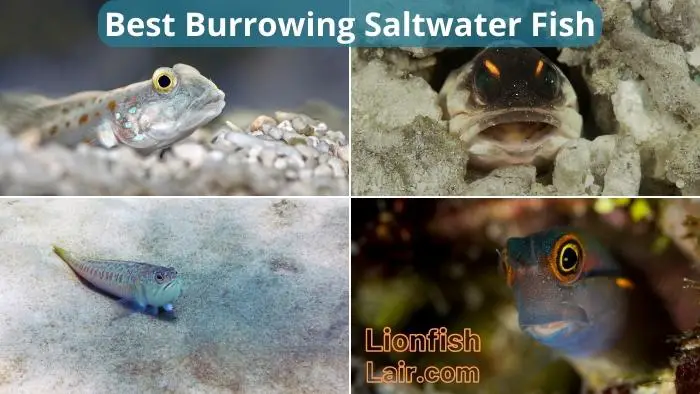
Saltwater Fish that Camouflage in Sand
I have curated an awesome list of the best saltwater burrowing fish that are known for their remarkable and unique ability to camouflage themselves in sand.
Beautiful Blennies
Blennies are unique and simply fantastic fish that are well-known for their burrowing behavior.
In the wild they reside in tropical and temperate waters and can be found inhabiting almost every ocean in the world, usually choosing coral reefs, rocky shores, rubble, and sand flats as their homes.
Their appearance is certainly something to behold, with elongated bodies and large eyes with an almost constantly open mouth. Blennies have a dorsal fin that runs across their body, taking up the appearance of two separate fins.
Most blenny species burrow in sand as a protective measure against predators, whilst allowing them to patiently wait and ambush unsuspecting prey at the same time.
In the graphic below I have created a compilation of images of some of the popular blenny species for beginner to expert fish keepers:
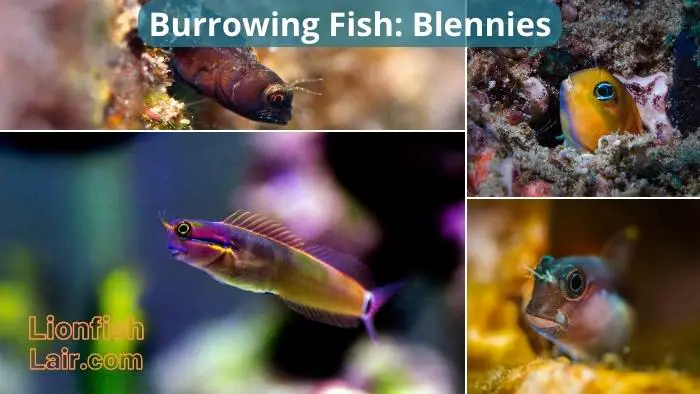
- Midas blenny
- Orange spotted blenny
- Bicolor blenny
- Canary blenny
- Sailfin blenny
- Two spot blenny
- Forktail blenny
- Starry blenny
Something that makes blennies such a popular fish for hobbyists is that each subspecies displays beautiful and bright coloration as well as distinctive patterns.
Additionally, they are very hardy fish, making them more than compatible with hobbyists of any experience level.
They also bring their sand burrowing etiquette to aquariums, which is always entertaining to observe.
It is, however, important that you do provide them with a sandy substrate to allow them to do what they do best!
If you are looking for some great sand/substrate for your aquarium that will allow your fish to do some burrowing, then you should check out these three options:
- AquaNatural Oolitic Aragonite Sand - a brilliant aquarium sand, suitable for all saltwater fish tank environments.
- CaribSea Fiji Pink Sand - another fantastic sand choice, slightly more expensive than the previous recomendation, but worth it if you are looking for the best quality.
- CaribSea Hawaii Black Substrate - this awesome substrate is black in color, making it incredibly cool, whilst being high in quality and will improve the look of any saltwater aquarium!
Great Gobies
Gobies are actually a member of the same family as blennies, with the main difference being that they are a much larger fish, growing no less than 7 inches (18 cm) in length.
This makes them more tailored to larger aquariums, which should usually be kept by more experienced hobbyists.
They are a ray-finned fish that can be found in all parts of the globe and are one of the most popular aquarium fish too.
Much like their blenny cousins, gobies tend to occupy reefs and shores, but they can also be found in rivers and estuaries!
Some of my favorite gobies suitable for home aquariums are in the image I created below:
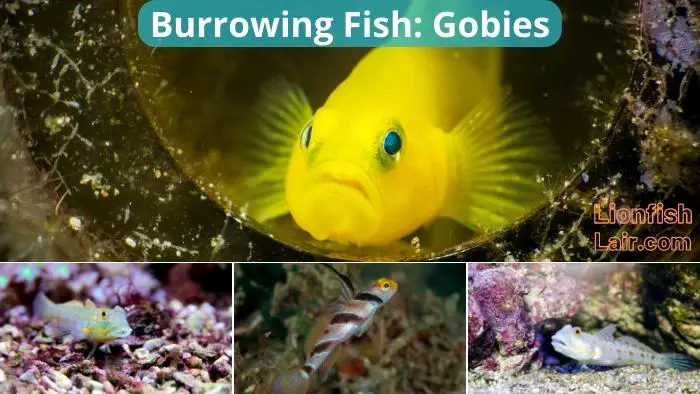
- Diamond goby
- Firefish goby
- Black ray goby
- Yellow watchman goby
- Yellow clown goby
Burrowing in sand and substrate is something that gobies love to do – they do so because it keeps them safe from predators and gives them an advantage when catching prey.
Something else they do it for is to regulate their temperature, however, this is only in the wild when the water temperature fluctuates more due to intense sunlight.
Wicked Weevers
Weavers belong to the Trachinidae family and are pretty much exclusively found throughout Europe, residing in the East Atlantic Ocean and the North Sea.
They enjoy the warm, shallow, and sandy waters that surround Ireland. Weevers can grow to a pretty large size, reaching up to 14.5 inches (37 cm) in length.
Also, they sport a brown/beige coloration and display many venomous spines across their gills and dorsal fins.
The image below displays the weever fish in all its glory:
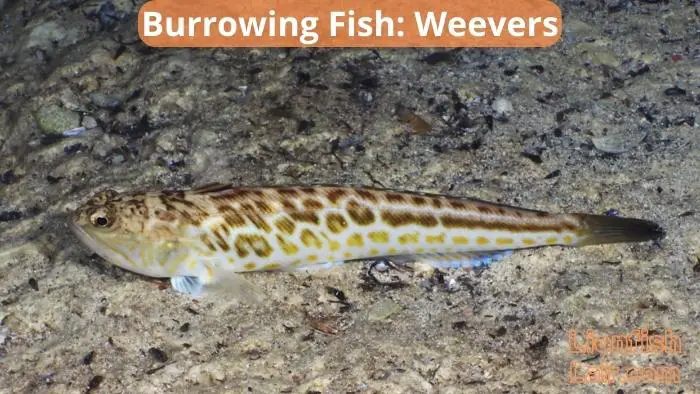
This coloration allows them to perfectly camouflage in the sand during the daytime, keeping them out of sight from predatory fish - their venomous spines also help with keeping them safe.
Typically, you will only see their eyes, mouth, and dorsal fin sticking out from above the sand.
Not only does their burrowing ability keep them safe, but much like the other burrowing fish mentioned here – it allows them to catch prey extremely easily and efficiently.
Typically feeding on small crustaceans whilst buried in the sand, but they certainly won’t say no to small fish either!
Weever fish are not commonly found in home aquariums, and they are actually very dangerous to humans due to their venomous spines, being named by many as the most dangerous fish in the UK!
Joyful Jawfish
Jawfish (Opistognathidae) are an incredibly interesting species that share very similar appearances and characteristics to the blennies and gobies I mentioned previously.
They are native to coral reefs in the Caribbean Sea and can be found in large numbers residing in the waters of Florida.
Every subspecies of jawfish is beautiful, truly a sight to behold, and their face and mouth shape is rather amusing too, which is usually the only thing displayed when they are buried in the sand!
Their reasons for sand burrowing are mainly predatory, however, like the other fish mentioned, it is a great way of keeping safe and regulating their temperature in the wild.
Some of the best jawfish to keep in a home aquarium are featured in the following graphic:
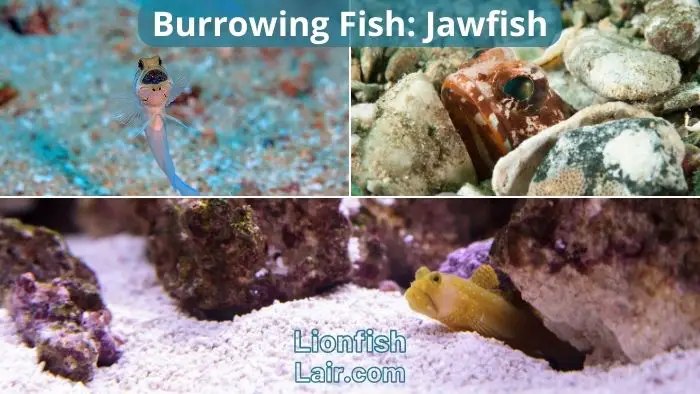
- Yellowhead jawfish
- Black cap jawfish
- Dusky jawfish
- Chinstrap jawfish
- Blue dot jawfish
In an aquarium setting, they make for perfect community members as they are very peaceful natured. They also enjoy the company of their own, usually being kept in either pairs or in small groups.
Jawfish are certainly a favorite here at Lionfish Lair, appearing on our list of the best 40 gallon saltwater fish!
Their omnivorous diet typically consists of greens such as plankton with the addition of crustaceans like shrimp.
My Final Thoughts on Burrowing Fish
Fish that use sand and substrate to hide themselves are truly remarkable, showing incredible intuition in order to protect themselves and also provide themselves with an easy way of catching prey.
The fish that are mentioned in my list are truly outliers, and I highly recommend keeping at least one of these species in your saltwater aquarium, should you own a reef tank.
Their behavior does not differ in an aquarium environment compared to in the wild as this etiquette has been passed down through many years of adaptation. Another very special species that shares this behavior is eels!
These menacing-looking predators use these tactics in a more sinister way than the others, and sometimes they will find caves and rocks to hide in, but it is still a common practice among them!

